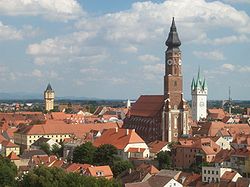
Straubing is a city of 48,000 people (2018) in Lower Bavaria. It is the center of the Gäuboden, a fertile plain along the Danube, and a gateway to the nearby Bavarian Forest. Straubing was the main city for large parts of the forest for almost six centuries.
Understand
[edit]History
[edit]The area of Straubing has been continuously settled since the Neolithic era. It was conquered by the Romans in 16–14 BC. Many traces of the 400-year Roman occupation can be found: for example, the famous 'Römerschatz' (Roman treasure) which was excavated in 1950 and which is shown in the Gäubodenmuseum. Sorviodurum, as the Romans called it, was an important military support base.
After the fall of the Roman Empire Straubing became a centre of settlement of the Bavarii, mostly around St. Peter's Church between Allachbach and Danube. According to the customs of the Bavarii the settlement was named after their leader Strupinga, which later evolved into the name Straubing.
In 1218 a new part of the city (called 'new town') was founded by Duke Ludwig I Wittelsbach of Bavaria. Straubing became the capital of the Duchy of Bavaria-Straubing under Duke Wilhelm I when Bavaria was divided among the sons of Louis IV, Holy Roman Emperor in 1349.
Between 1933 and 1945 most of the members of the then small Jewish community of Straubing were murdered or forced to emigrate. In 2006, Straubing had a lively Jewish community with around 950 members.
Straubing has many industrial areas and a port at the river Danube with access to the Rhine-Main-Danube Canal, a connection from the North Sea to the Black Sea. It is the centre of the Bavarian high tech offensive in biotechnology.

The Coat of Arms - virtually unchanged since the 13th century - contains the blue-white diamonds which would later be taken into the Wittelsbach Coat of Arms and have come to symbolize "Bavaria" in both official and folkloric contexts. Other elements of the Coat of Arms are a plow symbolizing the fertile Gäuboden and a Fleur de Lys symbolizing the old connection to the Bishopric of Augsburg to which Straubing used to belong ecclesiastically.
Tourist information
[edit]- .
Get in
[edit]By train
[edit]- 1 Bahnhof Straubing. On average, one to two regional trains run to Straubing from Munich or Regenburg every hour.
By car
[edit]Take the A3 motorway to the Kirchroth/Straubing exit.
By boat
[edit]As Straubing sits along the Danube, you can arrive here by boat, whether in your own watercraft or on a cruise.
Get around
[edit]See
[edit]The new town is the centre of Straubing with many shops, offices, restaurants and a pedestrian area. Most buildings there still have medieval style.
The most important buildings are the beautiful Gothic cathedral-like Basilica of St. Jacob, the Romanesque St. Peter's Church, the Carmelite monastery with its Baroque church and library, St. Vitus's, where you can find a life-size personification of "state and church" joined in holy matrimony.
The city square is often the point for a visit to Straubing. It is the major central axis of the late medieval new town (Neustadt), founded by the Wittelsbach dynasty in 1218. It is a pedestrian zone, shopping precinct, and a market place.
- 1 Herzogsschloss (Ducal Residence). Duke Albert I began construction in 1356. It is one of the five ducal residences of medieval Bavaria (besides Landshut, Munich, Ingolstadt and Burghausen).
- 2 Gäubodenmuseum, Fraunhoferstraße 23, ☏ +49 9421 944-63 222. Tu-Su 10:00-16:00. It exhibits the Roman treasure trove of Straubing with a unique collection of Roman face mask and Ross foreheads. It provides a cross-section through the cultures of prehistory and early history and the "Bajuwarenschatz", one of the most important and most beautiful archaeological Early Bavarian sources. Adult €4, reduced €3, child €1, child under 6 free, family €6.
- 3 Stadtturm. Built as a watchtower in the 14th-16th centuries. From the city tower, you can look down on the city, its gabled roofs, churches and towers in the Gäuboden and over the Danube into the Bavarian Forest.
- 4 St. Peter. A Romanesque church built in the 12th century.
- 5 Rathaus (city hall). Large parts of this city hall were destroyed by a fire in 2016.

- The Gothic Basilica of St. Jacob. Begun in 1393, the Basilica is a Gothic hall church and the largest main church of Straubing. The church was built according to plans of the architect Hans von Burghausen.
- 6 Wallfahrtskirche Sossau.
- 7 Synagogue. Built in 1907 its interior was totally destroyed by the Nazis in 1938 but the building was spared total destruction unlike most other synagogues in the country. A few objects of the pre-war interior (Torah scrolls, candelabras and so on) were anonymously returned to the police after the war by someone who had somehow safeguarded them during the pogrom and throughout the war.
Do
[edit]- 1 Zoo (Tiergarten) (about 45 min walk from the train station). Mar-Oct: daily 08:30-18:45; Nov-Feb: 09:00-16:45. 1,700 animals in 200 species in a large park area and with the replica of a Neolithic farmhouse. Adult €7, senior €6, child 5-15 €5, family tickets available.
- Straubing Tigers. The local Ice Hockey team playing in the first tier DEL.
Events
[edit]- 2 Gäubodenfest.
Buy
[edit]Eat
[edit]- 1 Kaffeehaus Krönner, Theresienplatz 1 (am Stadtturm). M-F 08:30 to 18:00, Sa 08:30 to 17:00. Birthplace of the Agnes-Bernauer-Torte.There are unhandled parameters: comment;
Drink
[edit]The nightlife of Straubing, with many pubs and discothèques, is concentrated in the new town.
Sleep
[edit]- Hotel Theresientor, Theresienplatz 51, ☏ +49 9421 8490, [email protected].
Camping
[edit]- 1 Campingplatz Straubing, Wundermühlweg 9, ☏ +49 9421 89794, [email protected].
Learn
[edit]- 1 TUM Campus Straubing für Biotechnologie und Nachhaltigkeit. An external campus of the Munich Technical University.There are unhandled parameters: 1;

